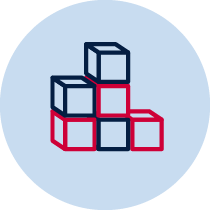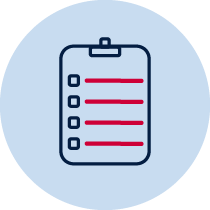Data – My collection notice and wonder
Gauge students' understanding of data concepts such as 'collections can be sorted according to different attributes'.
 |
 |
 |
 |
 |
| Build and make | Resource required | Verbal recording | Teacher observation | Individual |
Statistics and probability – data 1 and 2
- describes mathematical situations and methods using everyday language, actions, materials, diagrams and symbols MA1-1WM
- uses objects, diagrams and technology to explore mathematical problems MA1-2WM
- gathers and organises data, displays data in lists, tables and picture graphs, and interprets the results MA1-17SP
Syllabus content descriptors
- Choose simple questions and gather responses
- Represent data with objects and drawings where one object or drawing represents one data value and describe the displays
Linked syllabus content
Uses a range of strategies and informal recording methods for addition and subtraction involving one and two digit numbers MA1-5NA
Uses concrete materials and a number line to model and determine the difference between two numbers
Measures, records, compares and estimates lengths and distances using informal units, metres and centimetres MA1-9MG
Discuss strategies used to estimate lengths e.g. visualising the repeated unit, using the process ‘make, mark and move’.
National Numeracy Learning Progression mapping to the NSW mathematics syllabus
When working towards the outcome MA1‑17SP the sub-elements (and levels) of Interpreting and representing data (IRD1-IRD3) describe observable behaviours that can aid teachers in making evidence-based decisions about student development and future learning.
When working towards the outcome MA1‑9MG the sub-elements (and levels) of Understanding units of measurement (UuM3-UuM5) describe observable behaviours that can aid teachers in making evidence-based decisions about student development and future learning.
Materials
- collections of objects such as 30 multi-coloured counters or farm animals
- paper, pencils or recording device
Teacher instructions
The purpose of this task is to gauge students' understanding of data concepts such as:
- collections can be sorted according to different attributes
- by sorting and organising elements of collections by given attributes, generalisations can be made for example, there are more horses than chickens
- systematic organisation of data aids the making of generalisations
Present students with a collection of objects which they will ultimately use to create a graph. These could be counters of different colours, farm animals etc (at least 30 items). Using think-pair-share strategy, students are asked what they notice about their collection (What statements can they make?). Then, what do they wonder (What questions do they have?). Students choose one of their wonderings as an inquiry question which can be answered through sorting/categorising and organising. The following section provides a script for the teacher to deliver to the students for consistent application of the task, including enabling prompts should the students have difficulty getting started.
Prior to this task, students may benefit from seeing a picture graph so they know what it looks like to help when they need to organise their items.
Student instructions
Look at your collection of objects. What do you notice?
Turn to your partner and ask each other “what have you noticed?”
Now what do you wonder about your collection of objects?
Enabling prompt: What questions do you have about your collection?
Further enabling prompt if needed: I'm wondering about the colours, shapes and size of the items.
Write your question. Teacher could scribe the question if needed.
Thinking about your question, how could you sort or organise the objects in your collection.
If students just make piles, ask: Can you line up the ones that are the same? So we can compare the different groups?
What do you notice now?
The following questions could be asked during a one-to-one discussion with each student.
Can you explain anything else about your collection by looking at the way you have organised it?
Possible areas for further exploration
Possible misconceptions:
- No clear categories
- Informal display such as groups or piles.
- Using height of graph columns to determine greater quantities when the size of the objects are not equal or when equal-sized objects have not been evenly placed/spaced within data display
Where to next?
If categories are not clear, work with the student to identify attributes of given items. The card game Uno can be used to have students focus on attributes of colour and numerals.
Informal displays could be addressed through explicit teaching of organised displays.
Compare poorly constructed graphs to ideal models.
Students who are able to equally space their objects from a baseline and describe why same size objects are required could begin to construct diagrammatic representations from their models to move from the concrete representations.
Interpret data displayed in the graphs created by others.
Develop questions that can be investigated through the gathering of data.
Please note:
Syllabus outcomes and content descriptors from Mathematics K-10 Syllabus © NSW Education Standards Authority (NESA) for and on behalf of the Crown in right of the State of New South Wales, 2012